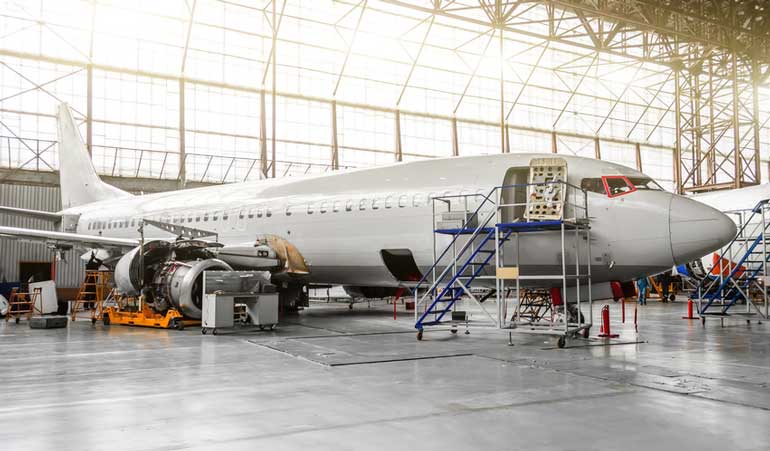Aircraft hangars are as ubiquitous to the aviation community as airplanes and aircraft themselves; if there are aircraft, it is reasonable to expect a hangar is close by. It is assumed a package deal, and for good reason: what would justify the expense of an aircraft without assuring its most fundamental protection from the elements? But housing is far from the sole purpose of a good aircraft hangar; maintenance hangars are a vital piece of the maintenance, repair, and overhaul (MRO) chain of events.
What are maintenance hangars for and where are they found?
Maintenance hangars are a much different entity than a line or storage hangar. Traditional line hangars have one primary function which is to safely and securely house the aircraft. They are not intended to be spacious or comfortable, but instead exist to house an airplane.
Maintenance hangars are designed and built from the ground up with a different purpose in mind. Used exclusively in the MRO arena, maintenance hangars are broad, wide-open arenas with the sole purpose of conducting major repairs on aircraft. Of course, this begs the questions: what constitutes a major repair? A major repair is anything that requires the removal and installation of power plants and associated accessories, as well as major structural and airframe components. It also envelops overhaul which is exactly as it sounds: overhaul includes major structural components as landing gear, flight controls and rigging, and systems repairs.
MRO hangars are not at every airport. They are pricey affairs, and they are not just installed to house and repair aircraft; they house all of the associated maintenance stands, scaffolding, tools, test stands, and even component overhaul backshops (hydraulic and pneudraulic system components, such as actuators and brakes, are overhauled for continued use). This is a level of maintenance known as base-level maintenance, as opposed to line maintenance which is the general servicing and inspection of aircraft (changing tires and brakes, making minor repairs to dents and skin, etcetera).
What are the most important features about maintenance hangars?
In a word: space. Base-level maintenance for aircraft is heavy duty work and it takes room to do it. When a maintenance team is dropping an engine, they need unmitigated room to work. They have to be able to maneuver the engine stand in place, move the engine from the stand to a transport dollie, and to safely move it out of the building.
Aircraft routinely have to be fully raised off of the ground to conduct landing gear swings for routine operations checks and post-rigging. This takes a very solid foundation which is perfectly level. Aircraft jacks attach to fixed hard points on the aircraft, and since there are only a handful of jacks used for the process, their footprint is extremely heavy. The flooring must be high-strength, high quality, and as mentioned, level.
An ergonomic design is of equal importance to raw space in terms of working efficiency in an MRO facility. If the floorplan is not well thought out, it will only succeed in costing more than necessary in regards to both initial construction, as well as utilities and upkeep. The gold standard for MRO facilities is tailoring the building to the mission. If an MRO operation is geared towards Bombardier Dash 8 aircraft, do not build the hangar for a Boeing 737 Max. This is not always avoidable as MRO facilities often are tasked with repair of a wide assortment of airframes, but the greatest extent possible it behooves the operator to refrain from overbuilding for no reason other than that they can.
What differences distinguish a maintenance hangar from a parking hangar?
Parking hangars have a single purpose: park as many airplanes inside as possible. These facilities are intended to be built as a wide-open bay, and the operator is money ahead when they can fill it to the brim with static aircraft. This is not a good working model when you are working on aircraft, though.
Aircraft maintenance is comprised of many moving pieces, and the pace is fast. Having the right ground support equipment is vital for the process to remain smooth and efficient, and one surefire means of slowing operations is to restrict movement.
Maintenance hangars must be designed in such a way that necessary support equipment is available immediately, docked and stowed for service. The maintenance hangar must be equipped with a parts hold or supply point, shipping and receiving on location. These are unique attributes that a storage hangar does not necessitate.
Tools that accelerate the maintenance process
Speaking from personal experience, having the right tool for the job makes all of the difference in the world. Nothing ruins a day faster than being in the middle of a flight control test and having a hydraulic test stand go out.
The most accurate solution to this problem is not so much what specific tool makes the process faster and smoother, but ensuring that you have the best tools available. Ground support equipment (GSE) like aircraft tugs, power carts, start carts, and test stands are the lifeblood of the MRO operation, and any money saved in purchasing lower cost, inferior GSE will quickly go right back out the door in either repair costs or time lost.
The aircraft tug represents the epitome of usefulness and efficiency in the GSE stable. It is truly an underappreciated tool, yet it easily makes or breaks the operation. If the tug is out of commission, the entire operation stands still. Every aircraft movement ties up four or five team members because that is what it takes to move an aircraft, unless you choose a remotely operated tug. What this does is simply revolutionize your entire MRO shop process, because now a single member of the work team can conduct the entire aircraft movement, leaving the rest of the team to set up shop for the next aircraft in line. It does not sound like a whole lot, until you think about five people on an average tow operation. If the entire tow procedure, from hooking up, transit, and detaching, were to take an hour (not unreasonable at large airports where you will be towing for long distances), then five man-hours have just been spent on a task where one would suffice.
Along the same line of thought as the tug, the use of autonomous technology in an MRO is earth shattering. Automated Guided Vehicles (AGV) are a tremendous advance for maintenance because now major structural components and engines can move safely through the facility completely autonomously with laser precision; they are placed exactly on location every single time.
Examples of exemplary maintenance hangars
One of the marquee examples of an effective maintenance hangar is the Qantas hangar at LAX, where base maintenance is performed on their Airbus A380 aircraft. This is an excellent example of creating a non-home station MRO facility to capitalize on scheduled aircraft downtime.
The American Airlines Tulsa Base Maintenance facility is the largest MRO in the world, with over 3.3 million square feet of combined hangar space in 22 buildings, it services nearly 800 aircraft annually, and roughly 100,000 components pass through for repair every year. The amazing part about this campus-style facility is that they work exclusively on American Airlines (AA) aircraft and parts, rather than sub-contracting manpower to other operators which is an industry norm. This allows AA to dictate quality control internally throughout all stages of the MRO process.
Other considerations
Maintenance hangars are a big investment, as is the GSE housed within. To fully master productivity in the work environment, maintenance operators must commit wholly to the tools which aid the process. AGVs are as much the wave of the future in aerospace as UAVs are, which has been apparent for quite some time. Traditional MRO movement of engines and other major components has been to hook up a small warehouse tractor to the engine cradle or wagon and tow it around. Time and again, human error has shown to be the most prevalent source of damage and loss in ground operations. Removing human error from the equation affords MROs the potential savings of millions of dollars in damage repair, and hundreds if not thousands of man-hours due to re-work.
Conclusion to maintenance hangars
Maintenance hangars are critical to the MRO process. Not only do they protect equipment and personnel from the elements, but they are a driving force in the process as a whole. Poorly designed maintenance hangars slow servicing because of inefficiency. The floorplan must be made to match the vision of the organization, and capable of adapting to changes and expansion. Builders should be realistic to the current needs of the organization, but also cognizant of the direction that the organization is taking. Investing in quality equipment up front will yield untold benefits in the future, and MROs must stay ahead of the curve in advancing technologies.
You are working in a (maintenance) hangar and want to improve your performance? Get our free eBook on hangar operations now!



Comments